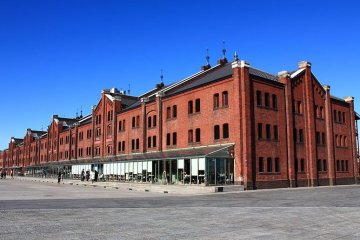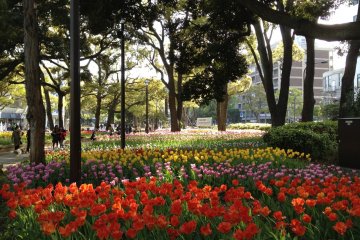

Yokohama International Passenger Terminal, also known as Osanbashi or Yokohama Port, is located at Osanbashi Pier. Osanbashi Pier, located between Minato Mirai and Yamashita Park / Chinatown, is the most important international port terminal for Japan due to its proximity to Tokyo many cruise lines from around the world stop by.
The 400 meter long pier has walkways and green spaces that are open to the public. It was originally built in 1894, but converted into a passenger terminal in 2002. The pier is one of the best places in Yokohama to get an unobstructed view of the Minato Mirai skyline. There are also shops, restaurants and a hall for small exhibitions and events here.
By train, Osanbashi Pier can be reached via a seven-minute walk from Nihon-Odori Station (Minato Mirai Line) or 15-minute walk from Kannai Station (JR, Yokohama Subway). By bus, Osanbashi Pier is accessible via the Akai Kutsu sightseeing bus (stop C15), from the Motomachi/Chinatown area heading towards Sakuragicho Station. On foot, Osanbashi Pier can be easily accessed from nearby sightseeing spots, between Yamashita Park and the Minato Mirai. The Akarenga Red Brick Warehouse is a 10-minute walk.

When Japan opened its market to the rest of the world in the late 19th century, Yokohama was the main port through which trade flowed to the Tokyo area. The red brick warehouse, also known as Akarenga, was opened during the Meiji -Time built in support of the port of Yokohama, it served as a customs clearance point to control the flow of goods through the port. Nowadays it has various shops and restaurants. The Event Plaza hosts markets and other outdoor celebrations. In addition, the warehouse has several event halls for concerts, exhibitions and more. The Red Brick Park also offers a spacious area of grass where you can relax and have a beautiful view of the bay and the passing ships.

Yamashita Park (山下公園) is a public park along YokoThe Yamashita Park is considered the first coastal park in Japan and is located directly in front of the port of Yokohama. It extends almost 700 meters from the east side of Osanbashi to the Yamashita Pier. It was founded in 1930 by filling the area with the debris of the great Kanto earthquake opened. The park includes a meadow of grass, a rose garden, the "Little Girl in Red Shoes" statue, the "Guardian of the Water" statue, which is a gift from San Diego, a sister city of Yokohama, and the memorial to that Song "" Kamome no Suihei-san (Seagull Sailor) "", a water staircase and a stage. The former cargo and passenger ship Hikawamaru is anchored here.hama's waterfront. The park was built using landfill from the remains of buildings destroyed in the Great Kanto Earthquake of 1923.

Yokohama Park is the second oldest park in Yokohama after Yamate Park and was opened to the public in 1897. With the construction of Yokohama Stadium, the dilapidated facilities of the park were renovated and a Japanese garden-style pond and creek, a fountain and a river were renovated Multipurpose space expanded. Around 140,000 tulips of around 70 varieties will be planted in Yokohama Park in November. The flowering time varies depending on the variety, but depending on the weather, the tulips are usually in full bloom from the beginning to the end of April. The park is a particularly popular travel destination at this time.